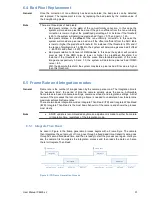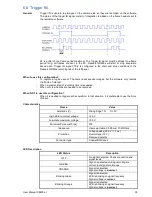
User Manual X8400 sc
30
6.1.3 One point Correction (offset correction)
General
The NUC correction is strongly depending on the optical path in front of the detector, and the
detector setup itself. It is common that any change on the camera or detector settings
requires a new NUC. However, this change is mainly in the offset response of the image
while the gain component stays constant. An Update Offset simply computes a new offset
coefficient using the existing gain coefficient and corrects the image non-uniformity.
An Update Offset requires only one uniform source, usually set at a temperature on the lower
edge of the operational range.
One point correction is done when clicking the Calibrate Button in ResearchIR Max Camera
Panel (#11 of §4.4.3)
6.2 Temperature Calibration
6.2.1 Hypercal™
General
Hypercal™ is a proprietary temperature measurement process which complements the
CNUC™. With Hypercal™, for any integration time selected, the camera produces accurate
measurement within +/- 1°C or +/-1% over the Measur ement configuration. Therefore it
makes the selection of the optimal measurement range for a given thermal scene an easy
task.
Note
•
+/- 1°C or +/-1% accuracy is standard for X8400sc camera, unless explicitly
specified. Typically, calibration on custom spectral filters or custom optical
configurations can show higher accuracy tolerances.
6.2.2 AutoExposure
General
Because the dynamic range of a natural thermal scene can be larger than the range of the
camera, some images taken by a camera can be saturated. When an image is ranged on the
bottom part of the dynamic range, the sensitivity is affected; therefore the integration time has
to be increased. Conversely, when an image is saturated on the higher part of the dynamic
range, the integration time has to be decreased.
When activated, the camera will search for the highest integration time for which the image
dynamic range is contained in the upper part of the linearity domain of the detector.
AutoExposure can be started from ResearchIR Max interface (see §4.4.5) or from the camera
LCD (see Figure 3 page 13).
Note
•
The autoexposure process looks for the best integration time for the actual thermal
scene. It may happen that this preferred integration time is not achievable because
of the actual camera frame rate. In this case, the auto exposure process is stopped
and the preferred integration is not applied
•
The autoexposure process is not designed to handle multiple integration times
6.3
Содержание X8400sc
Страница 1: ...User Manual X8400 sc 1 X8400sc User Manual Document Number DC085U Version C Issue Date 08 03 2013...
Страница 42: ...User Manual X8400 sc 42 4 Connect to http 192 168 64 1...
Страница 48: ...User Manual X8400 sc 48 7 3 Mechanical General Below are the mechanical interfaces...
Страница 49: ...User Manual X8400 sc 49...
















































